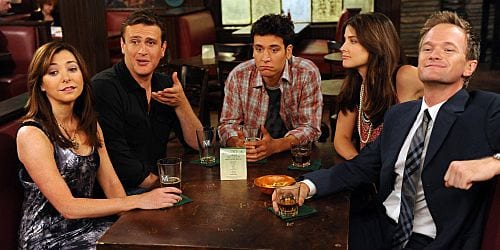
After a less than stellar fifth season—a fact even the stars and producers cop to—the CBS sitcom How I Met Your Mother returned to form in season six. The show uses some of the most intricate and sophisticated narrative structures and story telling techniques of any network television show since Arrested Development. Plots circle back around on themselves, seemingly inconsequential points from earlier seasons pop up in roles of great significance, giving the show a continuity rarely found in a 30-minute sitcom. Episodes employ multiple point of view characters, an unreliable narrator takes center stage, and on and on. The series is a grab bag of literary techniques that create an air of freshness to what is essentially a romantic comedy.
The most commonly voiced complaints about the show center around the protagonist, New York architect Ted Mosby (Josh Radnor), and his constant, cloying search for “the One”. For those uninitiated, the entire series is framed as Future Ted (voiced by Bob Sagat) telling his children how he met their mother, which is apparently a very long, very involved tale. It can be an annoying device, but let’s be honest, they kind of married themselves to that one from the get go. And in reality, I don’t think anyone, even those involved, expected the show to last this long. Standout cameos in the Harold and Kumar movies notwithstanding, who expected Neal Patrick Harris to be a legitimate star again? I certainly didn’t see that one coming.
Chiefly because Ted’s quest for love can be so grating, How I Met Your Mother works best when he has an extended love interest within a season, which allows the show to step back from his love life and focus on the other characters—playboy Barney (Harris), Canadian TV reporter Robin (Cobie Smulders), and ultra-adorable couple Marshall and Lily (Jason Segel and Alyson Hannigan)—who are more interesting, personable, and, overall, a lot more fun than Ted. Season Six gives you just that. Ted spends much of the run distracted by Zoey (Jennifer Morrison), an activist who is trying to stop one Ted’s designs from being built at the expense of an older structure.
Because Ted is otherwise occupied, the show has the freedom to explore more fertile narrative ground than it ever has before, and makes full use of this opportunity to touch on much deeper, more emotionally relevant themes. This is the year that the characters are confronted with the death of a loved one and have to cope with the fallout in their lives, in both a collective and individual sense. Barney’s lifelong search for his unknown father bears unexpected fruit. Marshall and Lily try to have a baby. Career and family issues take center stage. In short, the characters grow up more in Season Six than in any previous period on How I Met Your Mother’s run. They’ve moved out of the vapid frivolity of their twenties, into their thirties, becoming more fully realized human beings in the process.
How I Met Your Mother has always been a fun sitcom, one with engaging characters and imaginative story tropes that distinguish it from the monotonous herd. But in the sixth season, now on DVD/Blu-ray, the show developed an emotional weight and substance that it has often lacked, and the series ends up much stronger for it.
The home video release comes packed with a solid collection of bonus features. Multiple episodes feature commentary with the cast and crew. When you listen to show creators Craig Thomas and Carter Bays discuss the their schemes and plans for the season, you understand where a large portion of the material and tone for the show comes from. They have a similar back and forth to the characters, and could easily fit into one of the many scenes staged as McLaren’s pub, the gang’s regular hangout. Listening to the tracks with cast members from How I Met Your Mother, you know where the rest of the feel originates. The actors have an easy chemistry, and it is no wonder that they come across as such close friends on the show.
A couple of making-of installments are decent enough entries if you really want to explore every aspects of the show, but they’re nothing different from every other similar features you’ve seen. The deleted scenes, however, are much better than the norm. In most cases you know exactly why a particular scene was cut—it didn’t add anything new, it was unnecessary, or it simply wasn’t up to snuff. In this instance most of these scenes were edited out solely for time constraints, and contain material that is totally worth taking a look at. How often do you get to say that the deleted scenes on a DVD are too short and over too soon?

![Call for Papers: All Things Reconsidered [MUSIC] May-August 2024](https://www.popmatters.com/wp-content/uploads/2024/04/all-things-reconsidered-call-music-may-2024-720x380.jpg)



